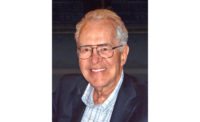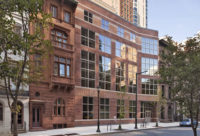Obituary: Robert Silman, 1935-2018

Robert Silman and his firm developed innovative ways to repair a sagging section of Fallingwater in Pennsylvania by Frank Lloyd Wright.
Photo © Kevin T. Quinn

Robert Silman worked with James Stewart Polshek and Richard M. Olcott of the Polshek Partnership on the Judy and Arthur Zankel Hall, located beneath Carnegie Hall in New York.
Photo © Jeff Golberg / Esto


Robert Silman, the structural engineer who died of cancer at his home in Great Barrington, Massachusetts on Tuesday, July 31, was at his best when masterpieces like Frank Lloyd Wright's Fallingwater needed his help.
Silman was a problem solver; 20 years ago, when a section of Fallingwater was found to be drooping seven inches, he developed innovative ways to fix it. He was a team player, who—before implementing his ideas—presented them to colleagues at a public forum. ''This is an icon, and I want to do it right,'' he said at the time. ''I want there to be a consensus.''
He was a patient teacher, walking reporters (including this one) through the causes of Fallingwater’s structural problems and the reasoning behind his planned repairs. And he could turn a phrase. Explaining the effect of temporary girders shoring up the house’s sagging balcony, he stated pithily: “The cantilever isn’t a cantilever anymore.”

Silman wasn’t an architect, but he had as much impact on the built environment as any architect of his generation. In the 52 years since he founded Robert Silman Associates (now known simply as Silman), the structural engineering firm has handled some 24,000 projects, according to its president, Joseph F. Tortorella. “He was the rare engineer who had an understanding of design intention,” says James Polshek, one of many prominent architects who turned to Silman repeatedly.
Educated at Cornell (B.A.) and NYU (bachelor’s and master’s in civil engineering), Silman worked for Ove Arup & Partners in London and Ammann & Whitney in New York before starting his firm in midtown Manhattan in 1966. As a solo practitioner in need of work, he took whatever jobs came in—which included rehabilitating burnt-out tenements. Those jobs, which larger firms didn’t want to touch, established Silman as a preservation expert. Soon he was getting calls about Ellis Island (where he helped turn the crumbling main building into an immigration museum) and Carnegie Hall. There, working with Polshek, he engineered not only the building’s 1980s renovation but the later creation of Zankel Hall—a performance space below the famous auditorium.
Fallingwater was just one of many Frank Lloyd Wright buildings Silman helped restore. They included Wingspread, the Racine, Wis., residence, where he used carbon fiber—a material unknown to Wright—to prevent leaks, and New York’s Guggenheim Museum, where he used lasers to map the building’s surfaces in preparation for a facelift. “We think it’s the largest laser model ever constructed,” he told the New York Times in 2007. Silman advocated resurfacing the Guggenheim with carbon fiber, to give it the pristine finish that Wright envisioned. The restoration architect, however, opted for a bumpy surface that ostensibly revealed the building’s craftsmanship.
Though it became best known for its preservation projects, the firm (which now has 170 employees in Boston, New York, and Washington) engineered thousands of ground-up buildings, including, in recent years, Renzo Piano’s Whitney Museum, Steven Holl’s new public library in Queens, SANAA’s Grace Farms in Connecticut and Freelon Adjaye Bond’s National Museum of African American History and Culture. Altogether, the firm has worked on buildings by 14 Pritzker Prize winners, according to Nat Oppenheimer, its executive vice president and senior principal.
In recent years Silman spent as much time as he could at his farm in Great Barrington, Mass., with Roberta, his wife of 62 years. She said that her husband was diagnosed with multiple myeloma in 1984 and that in 2017 he learned he had myelodysplastic syndrome, “another bone marrow cancer, which developed as a result of the chemotherapy he had to take back in the 1990s and early 2000s.” But he continued working until June, both at his firm’s Boston office and at Harvard University’s Graduate School of Design, where he taught a course called Philosophy of Technology. Thousands of architecture students there and at other schools (including Columbia and Yale) benefitted from his teaching. Silman “inspired interest in what engineers do,” says Karen Frome, an architect who took the course at Columbia in the late 1980s. In recent years, he subtitled the course “Technology and Responsibility.” “What are our responsibilities as we design the built environment?” he asked in the course description. “What do we owe the future?” He expressed his view of the fundamentals of his philosophy in a piece he wrote for Architectural Record in June.
At Silman offices, “It was never about having the biggest firm or making the most money—it was about having fun and doing a good job,” says Oppenheimer.
“He was a throwback, a mensch,” Oppenheimer adds. “If you wanted to start a firm that competed with him, he would help you out.





